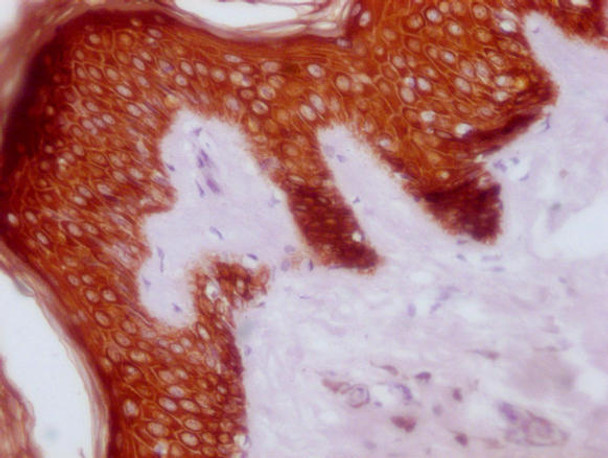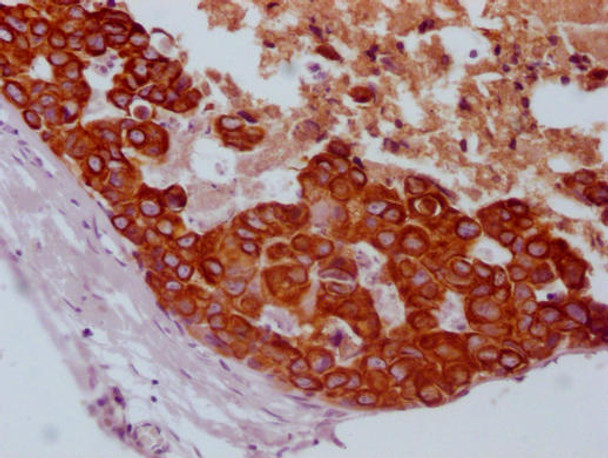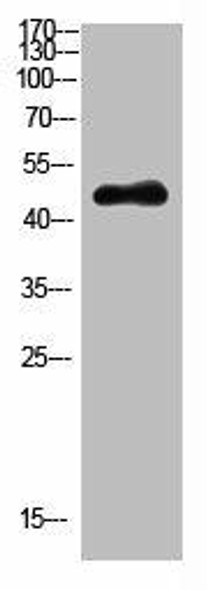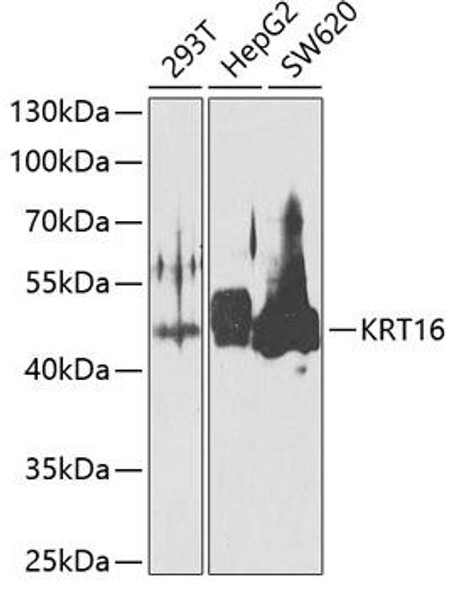Anti-KRT14/KRT16/KRT5/KRT6A/KRT8 Antibody (MACO0506)
- SKU:
- MACO0506
- Product Type:
- Antibody
- Reactivity:
- Human
- Host Species:
- Mouse
- Isotype:
- IgG2b, Kappa
- Applications:
- ELISA
- IHC
- Antibody Type:
- Monoclonal Antibody
- Conjugation:
- Unconjugated
Description
Anti-KRT14/KRT16/KRT5/KRT6A/KRT8 Antibody (MACO0506)
The KRT14/KRT16/KRT5/KRT6A/KRT8 Monoclonal Antibody (MAC0506) is a powerful tool for studying the expression and function of multiple cytokeratin proteins in various research applications. This antibody, generated using a monoclonal antibody technique, exhibits high specificity and sensitivity towards human samples.Cytokeratins are a group of intermediate filament proteins that play essential roles in maintaining the structural integrity of epithelial cells. The KRT14/KRT16/KRT5/KRT6A/KRT8 Monoclonal Antibody targets multiple cytokeratin proteins, including KRT14, KRT16, KRT5, KRT6A, and KRT8, allowing for the simultaneous detection and analysis of these important biomarkers.
This antibody is well-suited for use in techniques such as immunohistochemistry, immunofluorescence, and Western blotting, enabling researchers to investigate the expression patterns and distribution of cytokeratin proteins in different cell types and tissues. By understanding the functions and dysregulation of cytokeratins, researchers can gain insights into various diseases, including cancer, skin disorders, and epithelial-related conditions.Unlock the potential of cytokeratin research with the KRT14/KRT16/KRT5/KRT6A/KRT8 Monoclonal Antibody (MAC0506) and take your studies to the next level.
| Product Name: | Anti-KRT14/KRT16/KRT5/KRT6A/KRT8 Antibody |
| Product Sku: | MACO0506 |
| Size: | 50ul |
| Host Species: | Mouse |
| Tested Applications: | ELISA, IHC |
| Recommended Dilutions: | IHC:1:20-1:200 |
| Species Reactivity: | Human |
| Immunogen: | Synthesized peptide derived from human Cytokeratin Pan |
| Form: | Liquid |
| Storage Buffer: | Liquid in PBS containing 50% glycerol, 0.5% BSA and 0.02% sodium azide. |
| Purification Method: | The antibody was affinity-purified from mouse ascites by affinity-chromatography using specific immunogen. |
| Clonality: | Monoclonal |
| Isotype: | IgG2b, Kappa |
| Conjugate: | Non-conjugated |
| Background: | Cytokeratin pan is part of a subfamily of intermediate filament proteins that are characterized by remarkable biochemical diversity, and represented in human epithelial tissues by at least 20 different polypeptides. Cytokeratins range in molecular weight between 40 kDa- 68 kDa, and an isoelectric pH between 4.9-7.8. The individual human cytokeratins are numbered 1 to 20. The various epithelia in the human body usually express cytokeratins which are not only characteristic of the type of epithelium, but also related to the degree of maturation or differentiation within an epithelium. Cytokeratin subtype expression patterns are used to an increasing extent in the distinction of different types of epithelial malignancies. The cytokeratin antibodies are not only of assistance in the differential diagnosis of tumors using immunohistochemistry on tissue sections, but are also a useful tool in cytopathology and flow cytometric assays. The composition of cytokeratin pairs vary with the epithelial cell type, stage of differentiation, cellular growth environment, and disease state. Many studies have shown the usefulness of keratins as markers in cancer research and tumor diagnosis. |
| Synonyms: | CARD2; CK-4; CK-6C; CK-6E; CK-8; CK14; CK16; CK4; CK5; CK6A; CK6C; CK6D; CK8; CYK4; CYK8; DDD; DDD1; EBS2; EBS3; EBS4; FNEPPK; K14; K16; K1CP; K2C8; K4; K5; K6A; K6C; K6D; K8; KO; KRT14; KRT16; KRT16A; KRT5; KRT5A; KRT6A; KRT6C; KRT6D; KRT8; NEPPK; NFJ; PC1; PC3; WSN1; 58 kDa cytokeratin; CK-14; CK-16; CK-5; CK-6A; CK-6D; CK-8; cytokeratin 14; cytokeratin 16; cytokeratin 4; cytokeratin 6A; cytokeratin 6C; cytokeratin 6D; Cytokeratin-14; Cytokeratin-16; Cytokeratin-5; Cytokeratin-6A; cytokeratin-6C; Cytokeratin-6D; cytokeratin-6E; Cytokeratin-8; epidermolysis bullosa simplex 2 Dowling-Meara/Kobner/Weber-Cockayne types; focal non-epidermolytic palmoplantar keratoderma; Hom s 5; K14; K16; K5; K6A; K8; kamp-keratin derived antimicrobial peptide; KDAMP; keratin 14, type I; keratin 16, type I; keratin 4, type II; keratin 5 (epidermolysis bullosa simplex, Dowling-Meara/Kobner/Weber-Cockayne types); keratin 5, type II; keratin 6A, , type II; keratin 6A, type II; keratin 8, type II; keratin K6h; keratin, epidermal type II, K6A; Keratin, type I cytoskeletal 14; Keratin, type I cytoskeletal 16; Keratin, type II cytoskeletal 5; Keratin, type II cytoskeletal 6A; Keratin, type II cytoskeletal 8; Keratin-14; Keratin-16; Keratin-5; Keratin-6A; keratin-6C; Keratin-8; pankeratin; type-II keratin Kb12; type-II keratin Kb4; Type-II keratin Kb5; Type-II keratin Kb6; Type-II keratin Kb8 |
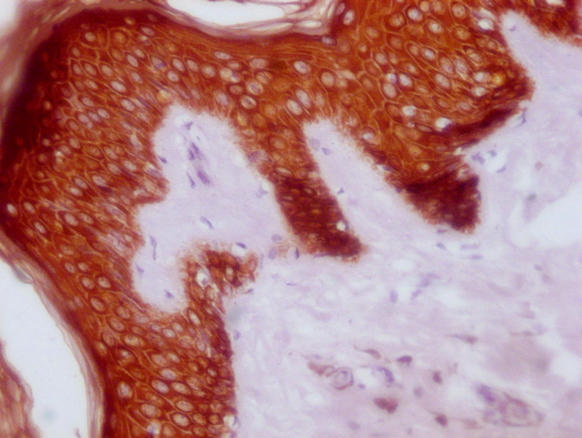 | IHC image of MACO0506 diluted at 1:100 and staining in paraffin-embedded human skin tissue performed on a Leica BondTM system. After dewaxing and hydration, antigen retrieval was mediated by high pressure in a citrate buffer (pH 6.0). Section was blocked with 10% normal goat serum 30min at RT. Then primary antibody (1% BSA) was incubated at 4°C overnight. The primary is detected by a Goat anti-mouse IgG polymer labeled by HRP and visualized using 0.05% DAB. |
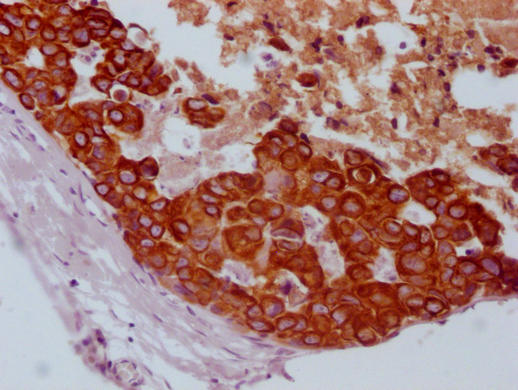 | IHC image of MACO0506 diluted at 1:100 and staining in paraffin-embedded human breast cancer performed on a Leica BondTM system. After dewaxing and hydration, antigen retrieval was mediated by high pressure in a citrate buffer (pH 6.0). Section was blocked with 10% normal goat serum 30min at RT. Then primary antibody (1% BSA) was incubated at 4°C overnight. The primary is detected by a Goat anti-mouse IgG polymer labeled by HRP and visualized using 0.05% DAB. |
| UniProt Protein Function: | K14: a type I cytoskeletal keratin. The keratins are intermediate filament proteins responsible for the structural integrity of epithelial cells and are subdivided into cytokeratins and hair keratins. There are two types of cytoskeletal and microfibrillar keratin: type I (acidic; 40-55 kDa) [K9 to K20] and type II (neutral to basic; 56-70 kDa) [K1 to K8]. Both a basic and an acidic keratin are required for filament assembly. Generally associates with K5. |
| UniProt Protein Details: | Protein type:Cytoskeletal Chromosomal Location of Human Ortholog: 17q21.2 Cellular Component: cytoplasm; keratin filament; intermediate filament; cytosol; nucleus Molecular Function:protein binding; structural constituent of cytoskeleton Biological Process: epidermis development; hemidesmosome assembly; epithelial cell differentiation; response to zinc ion; response to ionizing radiation; intermediate filament bundle assembly; hair cycle; aging Disease: Epidermolysis Bullosa Simplex, Localized; Epidermolysis Bullosa Simplex, Generalized; Dermatopathia Pigmentosa Reticularis; Epidermolysis Bullosa Simplex, Autosomal Recessive 1; Naegeli Syndrome; Epidermolysis Bullosa Simplex, Dowling-meara Type |
| NCBI Summary: | This gene encodes a member of the keratin family, the most diverse group of intermediate filaments. This gene product, a type I keratin, is usually found as a heterotetramer with two keratin 5 molecules, a type II keratin. Together they form the cytoskeleton of epithelial cells. Mutations in the genes for these keratins are associated with epidermolysis bullosa simplex. At least one pseudogene has been identified at 17p12-p11. [provided by RefSeq, Jul 2008] |
| UniProt Code: | P02533 |
| NCBI GenInfo Identifier: | 229463044 |
| NCBI Gene ID: | 3861 |
| NCBI Accession: | P02533.4 |
| UniProt Secondary Accession: | P02533,P08779, |
| UniProt Related Accession: | P02533 |
| Molecular Weight: | ~ 52kDa |
| NCBI Full Name: | Keratin, type I cytoskeletal 14 |
| NCBI Synonym Full Names: | keratin 14 |
| NCBI Official Symbol: | KRT14 |
| NCBI Official Synonym Symbols: | K14; NFJ; CK14; EBS3; EBS4 |
| NCBI Protein Information: | keratin, type I cytoskeletal 14 |
| UniProt Protein Name: | Keratin, type I cytoskeletal 14 |
| UniProt Synonym Protein Names: | Cytokeratin-14; CK-14; Keratin-14; K14 |
| Protein Family: | Putative outer capsid protein |
| UniProt Gene Name: | KRT14 |
| UniProt Entry Name: | K1C14_HUMAN |

